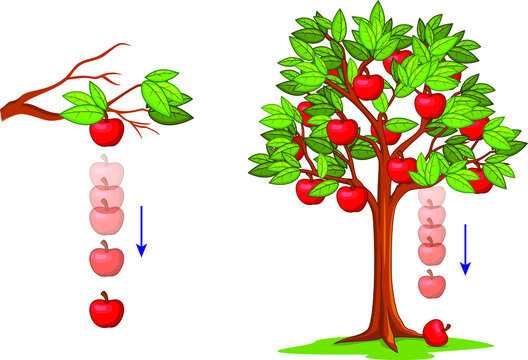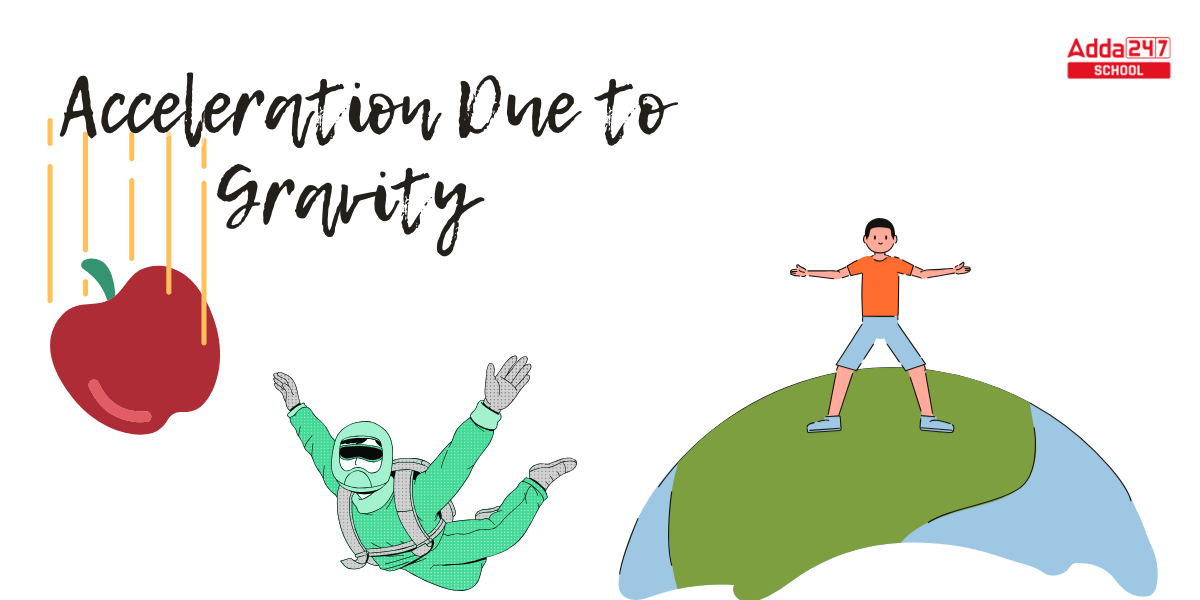Acceleration Due to Gravity: Acceleration due to gravity is the momentum gained by any object on Earth as a result of the force of gravity. The symbol ‘g’ is used to denote gravitational acceleration or Acceleration due to gravity. Gravity, also known as gravitational force, is defined as a force that pulls objects towards the center of mass, such as the Earth. In contrast, acceleration indicates how an object’s velocity or speed changes over time. As a result, the value of acceleration due to gravity on Earth is 9.8 m/s². The calculation formula Acceleration due to gravity is based on Newton’s Second Law of Motion and Newton’s Law of Universal Gravitation.
Acceleration Due to Gravity Definition
What is Acceleration due to Gravity?
Scientists have long noticed that when items drop from any given height, they fall to the ground. In overall, the speed with which an object descends to Earth rises as the height from which it is released increases. This means that as an object is released from increasing heights, its speed rises. By analyzing objects falling to the Earth in a variety of settings, scientists such as Sir Isaac Newton and Lord Henry Cavendish realized that this increase in speed, or acceleration, was triggered by a different force known as gravity (in simple terms Acceleration Due to Gravity). The SI unit of Acceleration Due to Gravity is ms2. It has both a magnitude and a direction. As a result, it is a vector quantity.
Acceleration Due to Gravity Example
Sir Isaac Newton observed an apple dropping from a tree while sitting under it. He then sought to find out why the apple fell to the ground rather than to the left or right. This led him to believe that there is a force dragging the apple towards the earth. Then he thought that the force of pull acting between all objects in the cosmos was called gravity or gravitation. In the same way, if we drop a stone from the second floor, it will fall to the ground rather than ascend to the sky, this is an Acceleration due to gravity example.

Acceleration due to Gravity Formula
The acceleration due to gravity is proportional to the mass of the item and inversely proportional to the distance from the center of mass, as expressed numerically as:
where,
g is the gravitational acceleration,
G is the gravitational constant,
m is the body’s mass, and
r is the distance from the center.
Acceleration due to Gravity Unit
Here all the important units of Acceleration due to gravity in SI and CGS method is given.
- Acceleration due to Gravity (g) = GM/r2
- Acceleration due to gravity is measured in SI units of m/s2.
- cm/s2 is the CGS unit of g.
- The dimensional formula for Acceleration due to Gravity is [ML0T-2].
- In SI, g stands for Acceleration due to Gravity.
- The g value in CG is 980 cm s-2.
Derivation of Acceleration due to Gravity Formula
Assume you have stood on the roof of the house, holding a little stone. So let the stone’s mass be m. When you throw a stone on the ground, the earth’s gravitational force pulls the stone downward. F = mg is the gravitational force acting on the stone.
We also know that the universal law of gravitation provides force between two objects. So one thing is the stone, and the other is the soil.
M = earth’s mass
m = stone’s mass
d = distance
mg = GMm/d², or g = GM/d²
Assume the object is on the earth’s surface or nearby. In this situation, d = R+ h.
As a result, g = GM/(R+h)2
or, we can say –
Acceleration due to Gravity on Earth
Let us compute the value of g on Earth or Acceleration due to gravity on Earth, h=0. Given that we understand the value of g,
G = 6.7 × 10-11 Nm²/kg²
M = 6 × 1024 kg
R = 6.4 × 106 m
So, by combining these values, we can calculate the acceleration due to gravity.
⇒g = 6.7×1011×6×1024 /(6.4×106)²
⇒ g = 9.8 m/s²
This is the value of Acceleration due to gravity on Earth. The magnitude of this gravitational acceleration varies depending on location. It is not an absolute constant.
Acceleration Due to Gravity on Moon
The acceleration due to gravity on the moon, or g on the moon, is 1.625 m/s2. Let’s Calculate the acceleration caused by gravity on the moon.
The gravitational acceleration formula is provided by –
Where,
G = 6.67410-11m3kg-1s-2 is the universal gravitational constant.
M is the huge body’s mass in kilograms/ kg.
R is the radius of the huge body, measured in millimeters/ m.
g is the acceleration due to gravity measured in millimeters per second / m/s².
- The moon has a mass of 7.35*10²²kg.
- The moon has a radius of 1.74*
m.
- By changing the values in the formula, we get-
As a result, the value of g on the moon is g=1.625 m/s².









 CBSE Admit Card 2026 for Private & R...
CBSE Admit Card 2026 for Private & R...
 AILET 2026 AIR 1: Check Full Toppers Lis...
AILET 2026 AIR 1: Check Full Toppers Lis...
 AILET Result 2026 OUT, How to Download S...
AILET Result 2026 OUT, How to Download S...














